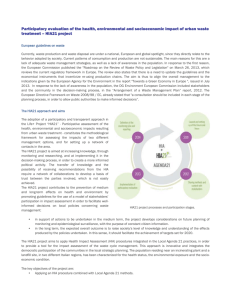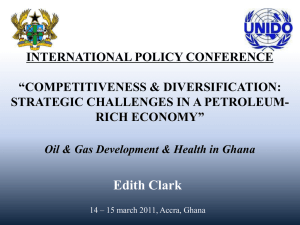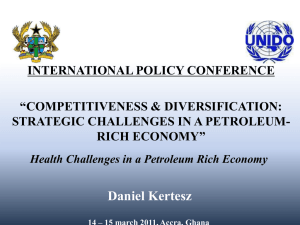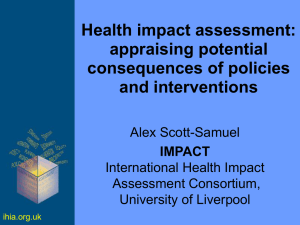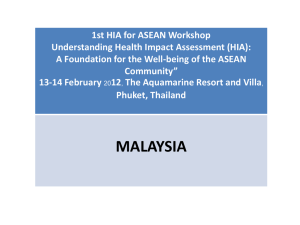Health Impact Assessment and Waste Management with particular reference to Incineration
advertisement
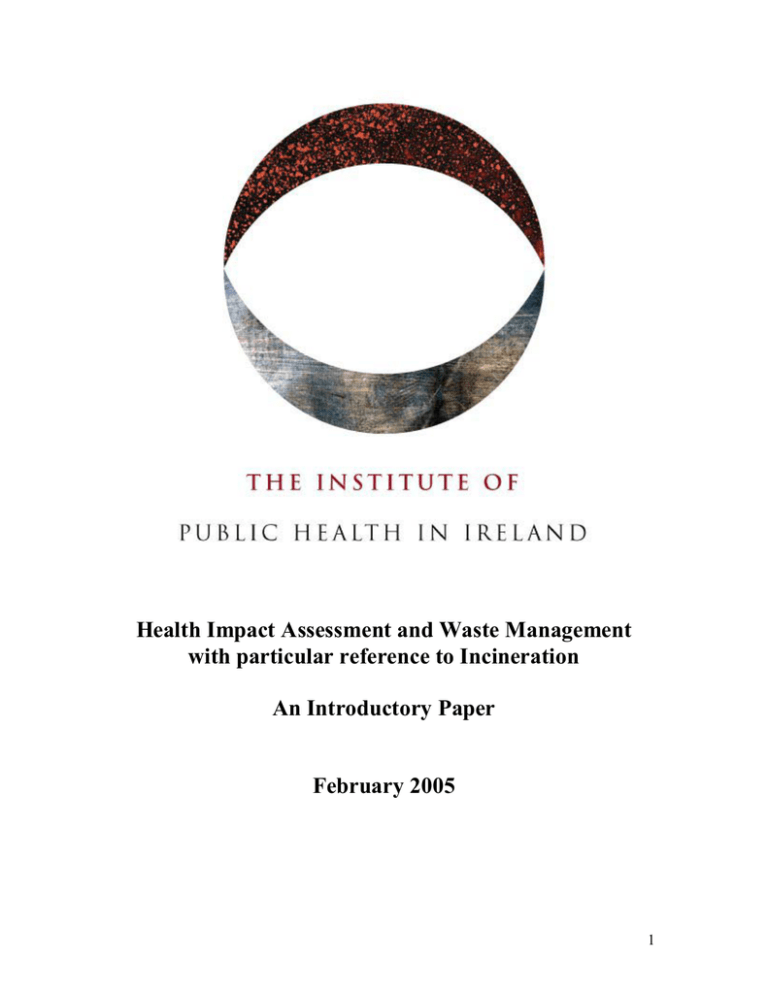
Health Impact Assessment and Waste Management with particular reference to Incineration An Introductory Paper February 2005 1 CONTENTS 1 Foreword 1 2.1 Waste production 1 2.2 Waste management in Ireland 1 2.3 Waste management and health 2 3.1 Health Impact Assessment 2 3.2 HIA and waste management 3 3.3 Conducting a HIA 4 3.3.1 Scoping 4 3.3.2 Appraisal 4 3.3.3 Report based on Evidence/Recommendations 5 3.4 Resources needed to conduct a HIA 5 Appendix 6 Bibliography 8 2 1 Foreword The Institute of Public Health in Ireland aims to improve health in Ireland and Northern Ireland by working to combat health inequalities and influence public policies in favour of health. Strategic objectives include producing information on health, health inequalities and contributing to the capacity of those who work to improve health. The Institute believes that Health Impact Assessment (HIA) can contribute to achieving these objectives. To date the Institute has produced a number of documents in this area, including a background paper and practical guidance on HIA, and is engaged in training programmes and capacity building. This introductory brief has been written as a response to a request for information on HIA and waste management, with particular reference to incineration. As such it will be of value to people who are working in or have an interest in this area. 2.1 Waste production The volume of waste generated in Ireland over the past number of years is outlined below. The increases seen are likely to be due to a combination of better quality information about the volume of waste produced and a real increase in resource use and waste generation (EPA 2004) Waste category/ Weight in tonnes Municipal Industrial Hazardous Construction & demolition Agricultural 1995 1,848,232 6,184,791 327,862 1,318,908 31,000,000 1998 2,056,652 9,074,751 370,328 2,704,958 64,578,724 2001 2,704,035 9,008,211 491,669 3,615,163 56,400,000 Source: Environmental Protection Agency 2.2 Waste management in Ireland EU legislation forms the basis for much of Irish waste management policy. Waste Management – Taking Stock and Moving Forward (2004) sets targets for increased prevention and minimisation, encourages reuse and gives preference to recovery and recycling, which is in line with the EU’s Sixth Environmental Action Plan (2002). In the area of waste incineration, the Waste Incineration Directive (2000/76/EC) has been transposed into Irish law and sets operating requirements for the incineration of waste. 3 2.3 Waste management and health Waste management and public health are inextricably linked and as such there is inherent sense in assessing the potential impact on health of any proposed method of managing waste. Such assessments can contribute to developing a greater understanding of the relationship between various forms of waste management and health. The relationship between waste incineration and health has been the subject of much debate. Reviews of epidemiological studies that explored the potential health risks to employees and to people living or working nearby found many results inconclusive due to a number of difficulties including: Where no evidence can be found of a relationship between adverse health effects and proximity to incineration sites this may mean that there is no relationship or that a relationship exists but may not be detectable using available methods and data sources. o The fact that ill-health may occur infrequently or take years to appear make it difficult to establish cause and effect. o Other confounding factors such as socio-economic variables, exposure to toxic substances from other sources, population variables and spatial and temporal issues make causality difficult to assess. o Further limitations with the evidence base include: o The fact that many studies conducted to date have concentrated on the effects of exposure to emissions from the older generation of incinerators, which have been phased out since the introduction of stricter emission controls. o Many studies have concentrated on the physical health outcomes, however a more holistic interpretation of health would also include psychological and social wellbeing. 3.1 Health Impact Assessment Health Impact Assessment is defined as a combination of procedures, methods and tools by which a policy, programme or project may be judged as to its potential effects on the health of a population, and the distribution of those effects within the population. HIA considers health to be determined by a broad range of factors such as employment, education, income level, social networks and lifestyle as well as age, sex and hereditary factors. It is a decision making tool which enables the health impacts of a proposal to be identified and can address inequalities by ensuring that all groups within the population are considered, especially those identified as being vulnerable. The concept of HIA has been developing over the past ten years with growing international support and is used extensively in Canada, Sweden, the Netherlands and Australia. In the European Union, the Amsterdam Treaty makes provision for HIA in 4 policy making and the public health action programme, commenced in 2003, promotes the development of HIA across Europe. The World Health Organisation has developed a HIA programme and set targets for member states to develop HIA mechanisms by 2010. HIA is carried out by progressing through a series of identified steps which recognise the positive and negative health impacts and assist decision makers to mitigate the harmful impacts and enhance the beneficial ones. It may be conducted at various stages in the development of an identified project, programme or policy. A prospective HIA is carried out in the developmental stage when findings and recommendations can influence decision making. Concurrent HIA is carried out when the identified proposal is being implemented while a retrospective HIA is carried out after the proposal has been implemented. Conducting a HIA on a proposal will aid the evidence base as it will: o Ensure specific stages of the proposal e.g. construction or operational stage, will be considered so that a comprehensive overview of the actions associated with health impacts are considered. o Enable the decision maker to be aware of the health impacts in order to extend the protection of human health and reduce the burden of ill health. o Promote greater equity in health. o Be used to assess the size of an impact o Allow stakeholders to participate more meaningfully in the formation of a project, policy or programme. o Make the decision making process more transparent. As a result of carrying out a HIA the positive and negative impacts will become clearer. Documenting this evidence and making it freely available can assist in addressing public concern over potential health impacts. 3.2 HIA and waste management A number of HIAs have been carried out in the area of waste management and more specifically on incineration of waste. Some examples are given in the appendix, however this is not an exhaustive list and a full search should be undertaken if conducting a HIA in this area. When reviewing the HIAs that have been carried out it is important to note that the evidence base is not fully authoritative in all areas and may be open to difference in interpretations or emphasis. Beliefs and perceptions are an intricate element of controversial proposals such as incinerators, however HIA has the potential to clearly set out both positive and negative impacts. 5 3.3 Conducting a HIA A framework for conducting a HIA has been developed by the Institute of Public Health. Although there are specific steps to be followed these should be used as a guide and may vary according to the specific circumstances. Given the proposed subject area of incineration, a HIA could be conducted as follows: 3.3.1 Scoping The scoping stage produces the blue print for the HIA and how it will be managed. It establishes a foundation for the rest of the assessment and usually commences with the establishment of a steering group. The purpose of the steering group is to engage stakeholders and ensure that the process is transparent. Upon consideration of the identified development the steering group may include representation from the following stakeholders: o Developer o Local Authority o Local Community Groups o Local Businesses o Relevant Government Departments such as Dept of Environment, Heritage & Local Government and Dept of Health & Children. Other members of the steering group might include those with expertise in the area which will help inform decisions, such as: o Waste Management specialists o Public Health specialists o Environmental Health specialists A chair will be agreed by the steering group to facilitate discussions and a record of all meetings should be kept for transparency. It will be the duty of the group to agree the terms of reference which will specify the aims and objectives and set out the work plan. This should address issues such as collecting evidence, research methods, timetable, costs and monitoring and evaluation. 3.3.2 Appraisal This process will be outlined in the terms of reference and involves gathering evidence on the health impacts of the proposal. A number of methods are likely to be used in gathering and analysing evidence including: o Proposal analysis: Exploring the proposal in depth in order to identify the health determinants likely to be affected 6 o Literature review: To be carried out on related policy interventions with regards to incineration and health. o Population profile: Establishes an overview of the affected population in an agreed geographical location, which is usually the area surrounding the proposal. o Quantitative research: Used to collect relevant data and to estimate changes in health status of some population groups in the future due to implementation of the proposal. o Qualitative research: Gathers evidence from the experience, knowledge, opinion and perceptions of the population to be affected by the proposal (stakeholders) and people with expert knowledge (key informants). 3.3.3. Report based on Evidence/Recommendations The information gathered should be prioritised to identify high, medium and low impacts in the short, medium and long-term. The strength of the evidence, likelihood and scale of the impact and the proportion of the population affected all need to be considered, as well as the distribution of effects amongst the population and how these effects may be experienced by vulnerable groups within the community. The Steering Group will agree the final set of recommendations which will be fed into the proposal, to achieve the objective of maximising health gain and minimising health loss. 3.4 Resources needed to conduct a HIA The depth of a HIA may vary depending on the circumstances and resources available. Historically HIAs may vary from desktop exercises which may take a few days to comprehensive exercises which may take several months or longer. Health Impact Assessments are most likely to inform decision-making if the decisionmakers feel that they own the assessment and are closely involved in all stages of the process. However it is important that there is a level of independence attached to conducting an HIA so that the results and recommendations can be presented in an impartial manner that supports a drive for improved health, particularly for those most directly affected by the project. 7 APPENDIX Household Waste Incinerator in Hull, England Background In 2001 a Household Waste Incinerator was proposed for Central Hull. The local Health Authority carried out a study to analyse the potential for health effects in the area. Whilst not a full HIA, the process contained many elements of a HIA and was carried out in response to local residents concern over the health impacts of incineration. Findings and recommendations As the Health Authority undertook the HIA it ensured that a number of recommended changes to the operating protocols for the incinerator were proposed which would provide additional safeguards for the health of the population of the region. The report concluded: o Dioxins may cause adverse health effects although there is very limited evidence that this is the case for low doses. o Evidence on health risks and incinerators and low doses of dioxins should be kept under review. o There is substantial evidence base to suggest that modern incinerator of household waste is unlikely to present a significant health hazard. o Where evidence of harmful emissions was detected these were either from hazardous waste or old systems that do not meet current regulations. o Issue of particulate size may be important but not completely understood. Landfill site in Parkwood, UK Background A retrospective HIA was carried out by North Sheffield Primary Care Trust in response to concerns expressed by residents living near the Landfill site. Findings and recommendations A Health Survey was carried out to determine whether people report more ill health if they lived close to a landfill site. The survey also considered the perception of selfreported ill health and results clearly showed that there was an increase in the number of self-reported symptoms particularly for bronchitis, skin, eye and nasal irritation and neurological symptoms closer to the landfill site. However research results showed there were no statistical significant differences between people living near to or further away from the landfill site. A Literature review was carried out and results were inconclusive however it was noted that there was a possible link with congenital anomalies. 8 Mayor’s draft Municipal Waste Management Strategy, London Background The Mayor of London developed a Municipal Waste Management Strategy to ensure municipal waste would not compromise London’s future as a sustainable city. A HIA was carried out by the London Health Commission, to identify the potential health impacts of the strategy. Findings and recommendations The completed HIA specifically looked at Waste Management as a whole and the results detailed how the strategy can be operationalised and ambitious targets set by the strategy achieved. The HIA identified the following: o There is a consistency between studies of general health effects of air pollution. o There are limitations of studies estimating the impact of single incinerators. o Policies reducing incineration will be beneficial for health of the general population as they will reduce levels of air pollution. o Energy recovery is beneficial to global health, though incineration plants should not replace other waste strategies. o Strong emphasis placed on waste hierarchy principle, favoring waste minimization over disposal by landfill or incineration. 9 BIBLIOGRAPHY Health and environmental effects of landfilling and incineration of waste – A literature review, Health Research Board Dublin, 2003. Health Impact Assessment – A practical guidance manual, Institute of Public Health in Ireland, 2003. Health Impact Assessment, John Kemm, Jayne Parry, Oxford University Press, 2004. Health Impact Assessment – The Mayor’s draft Municipal Waste Management Strategy, London Health Commission, 2001. Accessed online at: http://www.london.gov.uk/mayor/health_commission/health_index.htm Incineration and Health Issues, Friends of the Earth, 2002. Accessed online at: www.foe.co.uk Municipal Solid Waste as part of Ireland’s Integrated Waste Management Strategy, Environmental Protection Agency, 2004, Accessed online at: http://www.epa.ie/AboutUs/BriefingPapers/ National Waste Database 2003 Interim Report, Environmental Protection Agency, 2004. Accessed online at http://www.epa.ie/NewsCentre/ReportsPublications/Waste/ Parkwood Landfill Site Health Impact Assessment Summary, North Sheffield Primary Care Trust, 2003. Accessed online at: http://www.sheffield.nhs.uk/healthdata/landfillreport.htm Potential Health Effects of a Municipal Household Waste Incinerator in Stoneferry, Hull, Andrew Taylor, East Riding and Hull Health Authority. Personal communication Feb 2005. Waste Incineration and Public Health, National Research Council Committee on Health Effects of Waste Incineration, National Academy of Sciences, 2003. REFERENCES Crowley D, Staines A. et al (2003), Health and environmental effects of landfilling and incineration of waste – A literature review, Health Research Board, Dublin. 10 Environmental Protection Agency (2004), Municipal Solid Waste as part of Ireland’s Integrated Waste Management Strategy, Briefing paper accessed online at: http://www.epa.ie/AboutUs/BriefingPapers/ Environmental Protection Agency (2004), National Waste Database 2003 Interim Report, Accessed online at http://www.epa.ie/NewsCentre/ReportsPublications/Waste/ Friends of the Earth (2002) Incineration and Health Issues. Accessed online at: www.foe.co.uk Kemm J, Parry J & Palmer S, (2004) Health Impact Assessment, Oxford University Press: Oxford. London Health Commission (2001) Report: Health Impact Assessment – The Mayor’s draft Municipal Waste Management Strategy, Accessed at: http://www.london.gov.uk/mayor/health_commission/health_index.htm National Research Council Committee on Health Effects of Waste Incineration (2003), Waste Incineration and Public Health, National Academy of Sciences. North Sheffield Primary Care Trust (2003) Parkwood Landfill Site Health Impact Assessment Summary, Accessed at: http://www.sheffield.nhs.uk/healthdata/landfillreport.htm Taylor A (unpublished report), An Overview of the Potential Health Effects of a Municipal Household Waste Incinerator in Stoneferry, Hull, East Riding and Hull Health Authority. 11

